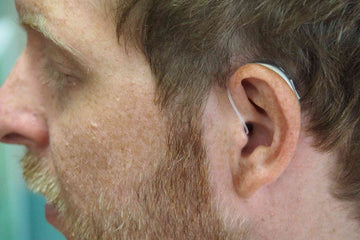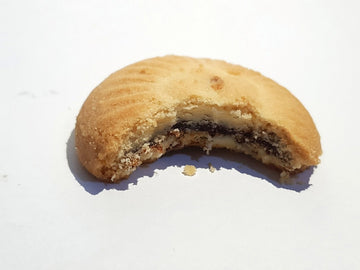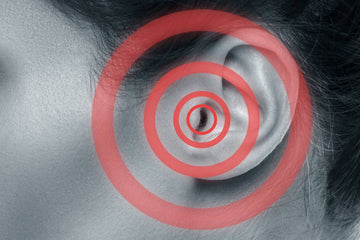Pros and Cons of Behind the Ear vs. In the Ear Hearing Aids
by Hear Clear on Nov 19, 2023

For those experiencing hearing loss, hearing aids can be a great way to improve communication, speak with confidence, and even watch your favourite TV shows with ease. But given that there are a number of different types of hearing aids available on the market, the first important step is determining which type is best for you.
For most people, Behind the Ear (BTE) and In the Ear (ITE) hearing aids are two of the most common choices, with both types effectively amplifying sound in either one or both ears. And while there’s no universal “better choice” between the two, each comes with its own set of advantages and drawbacks - so which one is right for you? Let’s take a look.
Behind the Ear vs In the Ear Hearing Aids: What’s the Difference?
Typically, BTE hearing aids consist of a small plastic case that sits behind the ear, connected to an earmold or earpiece that sits in the outer ear; this case contains the primary components of the hearing aid, including the microphone, amplifier, and speaker. BTE models are known for their versatility and can be used for a wide range of hearing losses.
On the other hand, ITE hearing aids are custom-made to fit entirely within the outer ear or ear canal, and what sets these devices apart is their discretion; they’re less visible compared to BTE aids and are designed to blend with the ear's natural shape. They house all the electronic components within one single shell and are suitable for mild to moderately severe hearing loss.
The key differences between these two types of hearing aids lie in their size, visibility, and the degree of hearing loss they can accommodate. Generally, BTE aids are slightly more powerful and can be used for almost all types of hearing loss. While ITE aids offer a more discreet appearance, they may not be suitable for severe hearing loss.
Which Hearing Aid is Better, Behind the Ear or In the Ear?
Determining which hearing aid is "better" largely depends on your own specific needs, preferences, and the nature of your hearing loss. BTE hearing aids are often recommended for severe to profound hearing loss due to their greater amplification capabilities, but also for their practicality; they’re easier to handle and maintain, making them a suitable choice for children or individuals with dexterity issues.
ITE hearing aids, being smaller and less visible, are often preferred for cosmetic reasons and are - for obvious reasons - popular amongst young people. They’re also less likely to pick up wind noise and can be easier to use with telephones, but the downside is that their small size can make them challenging to handle for some users, and they may not be as effective in amplifying sound as BTE aids.
Ultimately, your choice between BTE and ITE hearing aids should be based on a thorough evaluation of your own hearing needs, your lifestyle considerations, and your own personal style preferences.
Factors to Consider When Choosing Hearing Aids

Degree of Hearing Loss
The severity of your hearing loss should be the primary factor in choosing a hearing aid: BTE hearing aids are generally more powerful, making them suitable for a wider range of hearing loss severities, including profound hearing loss, while ITE aids are typically used for mild to moderately severe loss.
Lifestyle and Activity Level
Your lifestyle and daily activities can also influence your choice, especially when it comes to practicality. If you’re very active, you might prefer ITE aids for their discrete nature and secure fit. BTE models tend to be more prone to contact damage given that their exterior parts are worn on the ear, so they’re not always the best option when it comes to physical activity.
Dexterity and Ease of Use
You should also consider your manual dexterity when picking hearing aids, as you’ll likely be adjusting them regularly in your day-to-day life. BTE aids, with larger components and controls, are often easier to handle and adjust, which is beneficial for elderly users or those with limited hand mobility. ITE aids, with their smaller size, can be more challenging to manipulate.
Cost
Hearing aids can be incredibly expensive, especially if you go private via a consultation. The good news is that we at Hear Clear offer affordable small hearing aids in UK for those with both unilateral and bilateral hearing loss.
The Bottom Line
Overall, both BTE and ITE hearing aids have their unique advantages and limitations, but the choice between the two should be based on a comprehensive evaluation of your hearing loss, lifestyle, cosmetic preferences, dexterity, and maintenance capacity. If you’re unsure which type is best for you, it can be helpful to consult with a hearing care professional to assess your specific needs and find the hearing aid that best fits your lifestyle.
FAQs
Are BTE hearing aids more expensive than ITE models?
The cost of a hearing aid varies depending on the technology and features of the hearing aid rather than the style, but both BTE and ITE aids come in a range of prices, from affordable to upmarket pricing.
Can I wear ITE hearing aids while playing sports or exercising?
Yes, ITE aids can be worn during most activities. However, it's important to protect them from excessive sweat and moisture.




